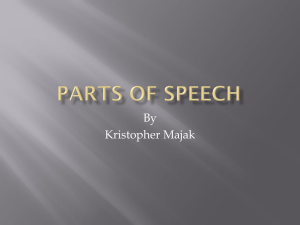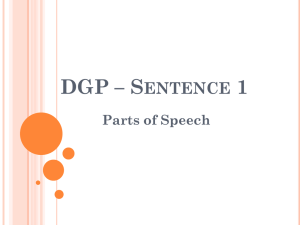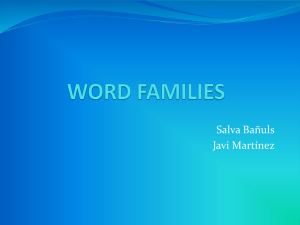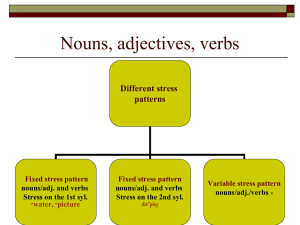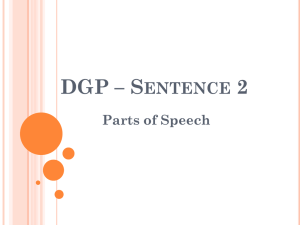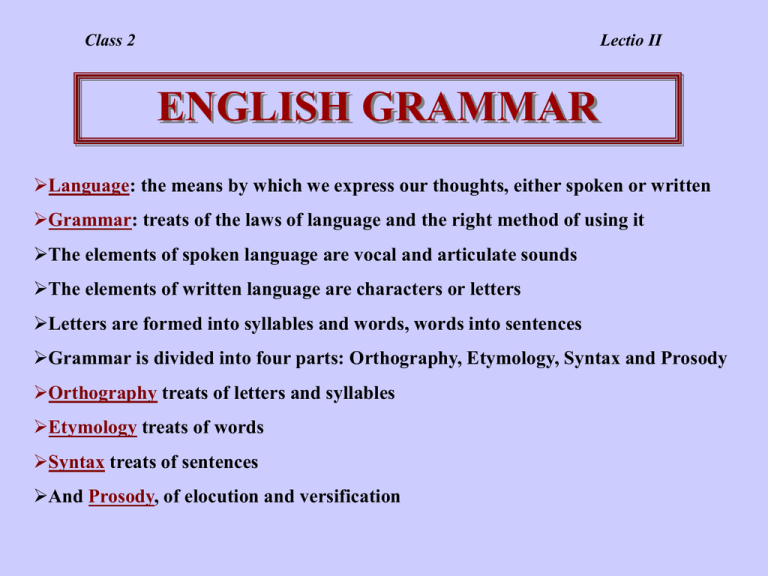
Class 2
Lectio II
ENGLISH GRAMMAR
Language: the means by which we express our thoughts, either spoken or written
Grammar: treats of the laws of language and the right method of using it
The elements of spoken language are vocal and articulate sounds
The elements of written language are characters or letters
Letters are formed into syllables and words, words into sentences
Grammar is divided into four parts: Orthography, Etymology, Syntax and Prosody
Orthography treats of letters and syllables
Etymology treats of words
Syntax treats of sentences
And Prosody, of elocution and versification
Etymology
Treats of the different sorts of words, and their various modification,
and their derivations
A Word is an articulate sound used by common consent as the sign of an idea
Words, in formation, are either Primitive or Derivative, Simple or Compound
A Primitive word is one that is not derived from another language
e.g. boy, just
A Derivative word is one that is derived from some other word
e.g. boyish, justice
A Simple word is one that is not combined with another word
e.g. man, house, city
A Compound word is one that is made up of two or more simple words
e.g. horseman
Words
Words are either inflected or uninflected
An Inflected word is one which undergoes certain changes of form or termination
nouns and pronouns are declined
verbs are conjugated
adjectives and adverbs are compared
In respect of signification and use, words are divided in classes called Parts of Speech
words which are names of objects are classed as nouns
words which qualify nouns are adjectives
words which attribute an action or state to a subject are verbs
Structure of Words
A simple word representing a single idea, whose origin is unknown, is a root
Derivatives are formed from these and also from foreign roots
by changing the vowel or modifying the consonants in the root
by prefixes and suffixes
a prefix is a letter or syllable before the root
a suffix is a letter or syllable after the root
Parsing
Parsing is the act of reducing a sentence into its basic elements
Parsing is classified as etymological and syntactical
A word is parsed etymologically by stating the class of words to which it
belongs
These are known as accidents or grammatical properties
Parts of Speech
Noun
Pronoun
Verb
Article
Adjective
Adverb
Preposition
Interjection
Conjunction
Only the noun, pronoun and verb (and
some adjectives and adverbs) are
inflected
Nouns
A Noun is the name of any person, place, quality or thing
Nouns are of two kinds, Proper and Common
A Proper noun is the name applied to an individual only
e.g. Igor, Moscow, Russia
A Common Noun is a name applied to all things of the same sort
e.g. woman, car, computer, test
The names of actions, as running, flying, etc. are called verbal nouns
Accidents of Nouns
Person, Number, Gender and Case
Person
Person is the distinction of nouns to denote the speaker, the person or thing
spoken to, or the person or thing spoken of
I, Claudius, have …
Professor, you can …
Gaius Julius was a …
Gender
Gender is the distinction of nouns with regard to sex
Masculine
Feminine
Neuter
Common
Number
Number is that property of a noun by which it expresses one, or more than one
Nouns have two numbers, the Singular and the Plural
Singular denotes one
Plural denotes more than one
Case
Case is the state or condition of a noun with respect to the other words in a sentence
English has three cases, the Nominative, Possessive and Objective
A noun is in the Nominative case when:
It is used as the subject of a finite verb
When used as a predicate
When used absolutely, or independent of any other word (Vocative)
The Possessive case connects the idea of origin, possession or fitness with a noun
e.g. sun’s rays, Anna’s car, women’s shoes
The Objective case is used to denote:
the object of a transitive verb, e.g. Matthew helps John
the object of a relation expressed by a preposition, e.g. She lives in Provo
time, value, weight or measure without a governing word, e.g. He is ten years
old
Articles
An Article is a word put before a noun to indicate the manner in which it is used
There are two articles, indefinite and definite
The indefinite article (a/an) denotes a noun without grammatical distinction
e.g. A man (i.e. any man, some man)
A definite article shows its noun refers to some particular person or thing
e.g. The man (i.e. some man pointed out)
Adjectives
An Adjective is a word used to qualify a noun (substantive)
Nouns, pronouns, adverbs and prepositions can be used as adjectives
sea water, she wolf, well child, above reference
Adjectives are of four types: Quality, Quantity, Circumstantial, and Participial
Adjective Types
Sensible
........................
Red
Comparative . . . . . . . . . . . . . . . . . . . . . . . . Long
Quality
Relational
........................
Definite numeral
Indefinite
Quantity
Circumstantial
Participial
Cardinal . . . . . .
Pleasant
One
Ordinal . . . . . . First
.......................
Few, many
Distributive . . . . . . . . . . . . . . . . . . . . . . .
Each
Measure
.......................
Much
Time
.......................
Daily
Place
.......................
Western
Nation (proper adj.) . . . . . . . . . . . . . . . . . .
German
Descriptive
Funny
.......................
Verbal (compound) . . . . . . . . . . . . . . . . . .
Unwanted
Comparison of Adjective
Three degrees of comparison: Positive, Comparative, Superlative
Positive expresses a quality
Iron is heavy, precious
Comparative expresses a quality in a higher degree
Gold is heavier, more precious
Superlative expresses a quality in the highest degree
Uranium is heaviest, most precious
Some adjectives cannot (should not) be compared, e.g.
Numerals, adjectives that denote shape, figure or material
(circular), definitives (this, that), or adjectives of an absolute or
superlative signification (perfect, true)
Pronouns
A Pronoun is a word used instead of a noun
The noun a pronoun replaces is called the antecedent
Pronouns are divided into Personal, Relative, Interrogative and Adjective
Personal Pronouns
Personal pronouns are pronouns that distinguish person. They
are simple substitutes for the names of persons or things and have
the same case, number and gender as the nouns they replace
Personal pronouns are either Simple or Compound
Simple Personal Pronouns
Compound Personal Pronouns
I
mine
me
myself
thou
thine
thee
thyself
you
yours
you
yourself
he
his
him
himself
she
hers
her
herself
it
its
they
itself
we
ours
us
ourselves
you
yours
you
yourselves
they
theirs
them
themselves
Used only in the nominative
(emphatic) and the objective
(reflexive)
Adjective Pronouns
Examples
Four classes
Possessive
Denote possession
my, thy, his, her, its, our, your, their
Distributive
Represent objects as taken
separately
each, every, either, neither
Demonstrative Point out object definitely
this, that, these, those
Indefinite
none, any, all, such, whole, both, one, other,
another
Designate object indefinitely
The Verb
A verb is a word used to express the act, being or state of a subject
(a subject is that person or thing whose act, being or state the verb expresses)
Classification of Verbs
Meaning or Office
Form
In formation of compound tenses
Transitive
Regular
Principle
Intransitive
Irregular
Auxiliary
Attributive
Defective
Verb Meaning
A Transitive verb expresses an act done by one person or thing to another
Augusta drives the chariot
An Intransitive verb expresses the being or state of its subject
I am. He is very happy
An Attributive verb asserts and connects an attribute with its subject
Grass is green. Man is mortal
Formation of Tenses
A Regular verb is one that forms its past tense in the indicative mood
active and it past participle, by adding –ed to the present
present act, past acted, past participle acted
An Irregular verb is one that does not form its past indicative and past
participle in this way
present write, past wrote, past participle written
A Defective verb is one in which some of the parts are wanting. This class
is comprised chiefly of Auxiliary and Impersonal verbs
e.g. may, can, must
Inflection of Verbs
The accidents of verbs are:
Voice, Mood, Tense, Number, Person
Voice
Voice is a particular form of the verb which shows the relation of the subject to the
action expressed by the verb
Transitive verbs have two voices, the Active and the Passive
The Active voice represents the subject as acting
Bernard hits the ball
The Passive voice represents the subject as acted upon
The ball is hit by Bernard
Intransitive verbs have no distinction of voice because they have no object which
can be used as the subject in the passive
They run, I stand
Some intransitive verbs can be made transitive and so capable of a passive form
I laugh. I laugh at him. He is laughed at by me
Mood
Mood is the manner or mode of expressing the signification of the verb
There are six moods in English
Indicative: declares the fact expressed by the verb
He loves. He is loved
Subjunctive: represents the action of the verb as conditional
If he works, he will improve. I wish you weren’t my professor.
Imperative: commands, exhorts, entreats or permits
Go away! Listen to his words. Follow the Prophet.
Potential: declares not the fact but the possibility of the verb
The wind may blow. Children should obey their parents.
Infinitive: expresses the meaning of the verb without distinction of person or number
to love
Participial: denotes action or state as continuing/incomplete or complete or finished without
regard to time
I saw him walking. The paper is written.
Tense
Tenses are forms of the verb which serve to point out the distinctions of time
English has either six or twelve tenses, depending on the grammar you follow*
In English there are three classes of tense:
Simple
Perfect
Progressive
Simple
Present: I walk
Progressive*
Past: I walked
Present progressive: I am walking
Future: I will walk
Past progressive: I was walking
Future progressive: I will be walking
Perfect
Present perfect: I have walked
Past perfect: I had walked
Present perfect progressive: I have been walking
Past perfect progressive: I had been walking
Future perfect progressive: I will have been walking
Future perfect: I will have
walked
*in some grammars the progressive tense is considered a form created by prefixing the verb “to be” (in all moods and tenses) to the present participle
Number and Person
Each tense of the verb has two Numbers, the Singular and the Plural
In each number, the verb has three Persons, the first, second and third
Conjugation of the Verb
Conjugation is the regular combination and arrangement of all
voices, moods, tenses, numbers and persons
Verbs have four principle parts
Present indicative . . . . . . . write
Present participle . . . . . . . . writing
Past indicative . . . . . . . . . . wrote
Past participle . . . . . . . . . . . written
Irregular Verbs
An irregular verb is a verb that does not form its past and past participle by
adding –ed to the present active indicative stem
e.g. cost
Defective Verbs
Verbs for which some of the parts are wanting
e.g. to beware [inf. and imp.]
Impersonal Verbs
Verbs that assert the existence of some action, but refer it to no particular subject
e.g. it behooves, it rains
Adverbs
An Adverb is a word that modifies a verb, adjective or another adverb
Manner………………..bravely
Place…………………..here, there
Time…………………..now, then
Direction………………upward
Classes of
Adverbs
Affirmation……………yes, certainly
Negation……………….no, not
Interrogation……………how? why?
Comparison…………….more, most, less
Quantity………………..much, some, little
Order ..…………………first, secondly
Prepostions
Are words which show the relation between the noun (pronoun)
and some other word in the sentence
e.g. The love of God
Rest in …………………….he is in the house
Place
Motion to or from ……….he went into the house
Rest or motion …………..over
Time
Time and place ………….at the place, at the time
Time only ………………..until evening
Agent
………..……………………by his authority
Cause
……………………………..for our sake
Separation ………………without
Inclination ………………for
Aversion ………………. .against
Misc.
Substitution …………….instead of
Possession ……………..of
Reference ………………..concerning
Opposition ………………against
Interjections
A word used in an exclamation to express an emotion of the mind
e.g. oh, alas
CONJUCTIONS
Conjunctions are words which connect words, phrases or sentences
e.g. and, or, nor
Conjunctions are of two classes, Copulative and Disjunctive
A Copulative joins sentences together and unites the meaning
Connective [connects the meaning]
e.g. The sun shines and the sky is clear
Continuative [combine the meaning]
e.g. The sun shines because the sky is clear
Disjunctives join two sentences together while disconnecting the meaning
Distributive [disconnect the meaning]
e.g. You can go or you can stay
Adversative [contrast the meaning]
e.g. It is day, but it is not light
Parsing Text
The minutest plant or animal, if it is examined
attentively, affords a thousand wonders and
obliges us to admire and to adore that omnipotent
hand by which it was created
Parsing Example
The . . . . . . . . . . . . . . . . . . . Definite article belonging to plant and animal
minutest . . . . . . . . . . . . . . . .Adjective, superlative degree, qualifying plant and animal
plant. . . . . . . . . . . . . . . . . . .Noun, neuter, nominative singular, subject of affords
or. . . . . . . . . . . . . . . . . . . . .Disjunctive conjunction, distributive, connecting plant and animal as alternative
animal . . . . . . . . . . . . . . . . .Noun, neuter, nominative singular, subject of affords
if. . . . . . . . . . . . . . . . . . . . . .Copulative conjunction, continuative, connecting the sentences
it. . . . . . . . . . . . . . . . . . . . . .Third personal pronoun, neuter, nominative singular, standing for plant or animal, and subject of is examined
is examined. . . . . . . . . . . . . .Verb, transitive, regular, present indicative, passive, expressing what is done to its subject it
attentively. . . . . . . . . . . . . . .Adverb modifying examined; compared by more and most
affords . . . . . . . . . . . . . . . . .Verb, transitive, regular, present indicative active, third person singular, and affirms of plant or animal
a . . . . . . . . . . . . . . . . . . . . . .Indefinite article, showing thousand wonders to be indefinite
thousand. . . . . . . . . . . . . . . .Numeral adjective, used to qualify wonders
wonders . . . . . . . . . . . . . . . .Noun, neuter, objective plural, object of affords
and . . . . . . . . . . . . . . . . . . . .Copulative conjunction, connective; connects the predicates affords and obliges
obliges. . . . . . . . . . . . . . . . . .Verb, transitive, regular, present indicative active, third person singular, and affirms of plant or animal
us. . . . . . . . . . . . . . . . . . . . . .First personal pronoun, objective plural, object of obliges and subject of admire, etc.
to admire . . . . . . . . . . . . . . . Verb, transitive, regular, present infinitive, active, attribute of us, or object of obliges
and . . . . . . . . . . . . . . . . . . . .Copulative conjunction, connective, connects to admire and to adore
to adore. . . . . . . . . . . . . . . . .Verb, transitive, regular, present infinitive, active, attribute of us, or object of obliges
that . . . . . . . . . . . . . . . . . . . .Demonstrative adjective pronoun, pointing out hand
omnipotent. . . . . . . . . . . . . . .Adjective, not compared, qualifying hand
hand. . . . . . . . . . . . . . . . . . . .Noun, neuter, objective singular, object of to admire and to adore
by. . . . . . . . . . . . . . . . . . . . . .Preposition which shows the relation between which and was created
which. . . . . . . . . . . . . . . . . . .Relative pronoun, related to hand as its antecedent, objective, object of the preposition by
it. . . . . . . . . . . . . . . . . . . . . . .Third personal pronoun, neuter, nominative singular, standing for plant or animal, and subject of was created
was created . . . . . . . . .. . . . .Verb, transitive, regular, past indicative, passive, third person singular, and affirms of it
A__________________________
N__________________________
B__________________________
O__________________________
C__________________________
P__________________________
D__________________________
Q__________________________
E__________________________
R__________________________
F__________________________
S__________________________
G__________________________
T__________________________
H__________________________
U__________________________
I__________________________
V__________________________
J__________________________
W__________________________
K__________________________
X__________________________
L__________________________
Y__________________________
M__________________________
Z__________________________


